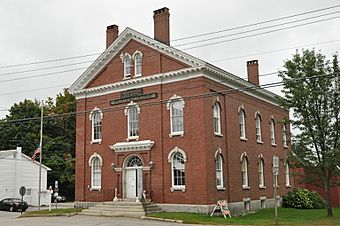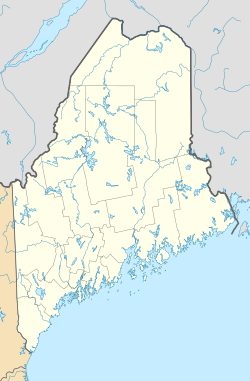Limerick Upper Village Historic District facts for kids
Quick facts for kids |
|
|
Limerick Upper Village Historic District
|
|

Limerick Town Hall (built 1860)
|
|
| Location | ME 5, Limerick, Maine |
|---|---|
| Area | 11 acres (4.5 ha) |
| Architectural style | Greek Revival, Italianate, Federal |
| NRHP reference No. | 84001557 |
| Added to NRHP | April 5, 1984 |
The Limerick Upper Village Historic District is a special area in Limerick, Maine. It's like a time capsule showing how the village looked long ago. This historic district covers about 11 acres. It stretches along Main Street, which is also part of Maine State Route 5.
The district includes buildings built from the early 1800s to the early 1900s. It was added to the National Register of Historic Places in 1984. This means it's recognized as an important place in American history.
Discovering Limerick's Past
The town of Limerick was first settled by people in the 1770s. It officially became a town in 1787. The town got its name from the city of Limerick in Ireland. This was the hometown of the father of James Sullivan. He was an important lawyer and one of the town's founders.
Main Street, which is now State Route 5, has a very old history. It used to be a footpath used by Native Americans. This path connected the coast to an inland community called Pequawket. Today, that community is known as Fryeburg, Maine.
Important Buildings and Styles
At the southern end of the district, you'll find the Baptist church. It was built in 1852. Next to it are the town's oldest cemeteries. The village spreads out along Main Street from here. It goes all the way to the Freewill Baptist Church, built in 1822. This church is located where Routes 5 and 160 meet.
The oldest building in the district is the Rev. Eastman House. It was built around 1790. It started as a Federal style building. Later, in the 1870s, it got new Italianate decorations. The Kilpatrick House, built around 1800, still looks like a Federal style building.
Many buildings in the district are in the Italianate style. This includes the brick town hall, built in 1860. The Academy and the library were both built in 1881. The Jeremiah Mason House, built in 1859, is a great example of an Italianate home made of brick. There is only one Queen Anne style building here. It's the Limerick National Bank building, built in 1881.



